Angiotensin receptor blockade has protective effects on the poststenotic porcine kidney
- PMID: 23615504
- PMCID: PMC3732527
- DOI: 10.1038/ki.2013.144
Angiotensin receptor blockade has protective effects on the poststenotic porcine kidney
Abstract
Angiotensin-converting enzyme inhibitors/angiotensin II receptor blockers (ARBs) may induce an acute decrease of glomerular filtration rate (GFR) in the stenotic kidney in renal artery stenosis, but most patients tolerate these drugs well. We hypothesized that angiotensin-converting enzyme inhibitors/ARBs stabilize stenotic kidney function during prolonged treatment by conferring protective effects. We tested this in control domestic pigs and pigs with renal artery stenosis untreated or treated with Valsartan, or triple therapy (seven pigs in each group) for 4 weeks starting 6 weeks after stenosis induction. Renal function, oxygenation, tubular function, and microcirculation were assessed by multi-detector computed tomography (CT), blood oxygen level-dependent magnetic-resonance imaging, and micro-CT. Valsartan and triple therapy decreased blood pressure similarly; however, Valsartan did not change the GFR of the stenotic kidney compared with renal artery stenosis and was similar to triple therapy. Both Valsartan and triple therapy stimulated microvascular density and improved tubular function. Valsartan also caused a greater increase of angiogenic factors and a decrease in oxidative stress, which were related to higher cortical perfusion and tubular response than triple therapy. Thus, Valsartan did not decrease stenotic kidney GFR, but improved cortical perfusion and microcirculation. These beneficial effects may partly offset the hemodynamic GFR reduction in renal artery stenosis and preserve kidney function.
Figures




Similar articles
-
Haemodynamic effects of valsartan in acute renal ischaemia/reperfusion injury.Nephrol Dial Transplant. 2001 Aug;16(8):1592-7. doi: 10.1093/ndt/16.8.1592. Nephrol Dial Transplant. 2001. PMID: 11477160
-
ACE inhibition or angiotensin receptor blockade: impact on potassium in renal failure. VAL-K Study Group.Kidney Int. 2000 Nov;58(5):2084-92. doi: 10.1111/j.1523-1755.2000.00381.x. Kidney Int. 2000. PMID: 11044229 Clinical Trial.
-
Changes in glomerular filtration rate after renal revascularization correlate with microvascular hemodynamics and inflammation in Swine renal artery stenosis.Circ Cardiovasc Interv. 2012 Oct;5(5):720-8. doi: 10.1161/CIRCINTERVENTIONS.112.972596. Epub 2012 Oct 9. Circ Cardiovasc Interv. 2012. PMID: 23048054 Free PMC article.
-
Valsartan and the kidney: present and future.J Cardiovasc Pharmacol. 1999;33 Suppl 1:S37-40; discussion S41-3. doi: 10.1097/00005344-199900001-00008. J Cardiovasc Pharmacol. 1999. PMID: 10028953 Review.
-
[Angiotensin II receptor blockers: current status and future prospects].Drugs. 2002;62 Spec No 1:53-64. Drugs. 2002. PMID: 12036389 Review. French.
Cited by
-
Atherosclerotic renal artery stenosis: current status.Adv Chronic Kidney Dis. 2015 May;22(3):224-31. doi: 10.1053/j.ackd.2014.10.004. Adv Chronic Kidney Dis. 2015. PMID: 25908472 Free PMC article. Review.
-
Kidney Intrinsic Mechanisms as Novel Targets in Renovascular Hypertension.Hypertension. 2024 Feb;81(2):206-217. doi: 10.1161/HYPERTENSIONAHA.123.21362. Epub 2023 Oct 23. Hypertension. 2024. PMID: 37869904 Free PMC article. Review.
-
Low-Energy Shockwave Therapy Improves Ischemic Kidney Microcirculation.J Am Soc Nephrol. 2016 Dec;27(12):3715-3724. doi: 10.1681/ASN.2015060704. Epub 2016 Jun 13. J Am Soc Nephrol. 2016. PMID: 27297945 Free PMC article.
-
The Metabolic Syndrome Does Not Affect Development of Collateral Circulation in the Poststenotic Swine Kidney.Am J Hypertens. 2018 Nov 13;31(12):1307-1316. doi: 10.1093/ajh/hpy127. Am J Hypertens. 2018. PMID: 30107490 Free PMC article.
-
Small Vessels, Big Role: Renal Microcirculation and Progression of Renal Injury.Hypertension. 2017 Apr;69(4):551-563. doi: 10.1161/HYPERTENSIONAHA.116.08319. Epub 2017 Feb 13. Hypertension. 2017. PMID: 28193706 Free PMC article. Review. No abstract available.
References
-
- Yusuf S, Sleight P, Pogue J, et al. Effects of an angiotensin-converting-enzyme inhibitor, ramipril, on cardiovascular events in high-risk patients. The Heart Outcomes Prevention Evaluation Study Investigators. N Engl J Med. 2000;342:145–153. - PubMed
-
- Yusuf S, Teo KK, Pogue J, et al. Telmisartan, ramipril, or both in patients at high risk for vascular events. N Engl J Med. 2008;358:1547–1559. - PubMed
-
- Dworkin LD. Controversial treatment of atherosclerotic renal vascular disease: the cardiovascular outcomes in renal atherosclerotic lesions trial. Hypertension. 2006;48:350–356. - PubMed
-
- Onuigbo MA, Onuigbo NT. Worsening renal failure in older chronic kidney disease patients with renal artery stenosis concurrently on renin angiotensin aldosterone system blockade: a prospective 50-month Mayo-Health-System clinic analysis. QJM. 2008;101:519–527. - PubMed
Publication types
MeSH terms
Substances
Grants and funding
LinkOut - more resources
Full Text Sources
Other Literature Sources

